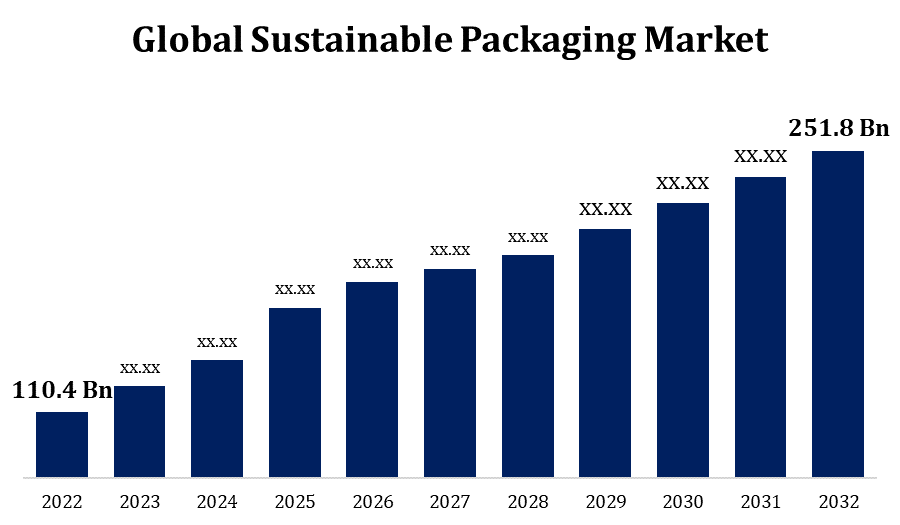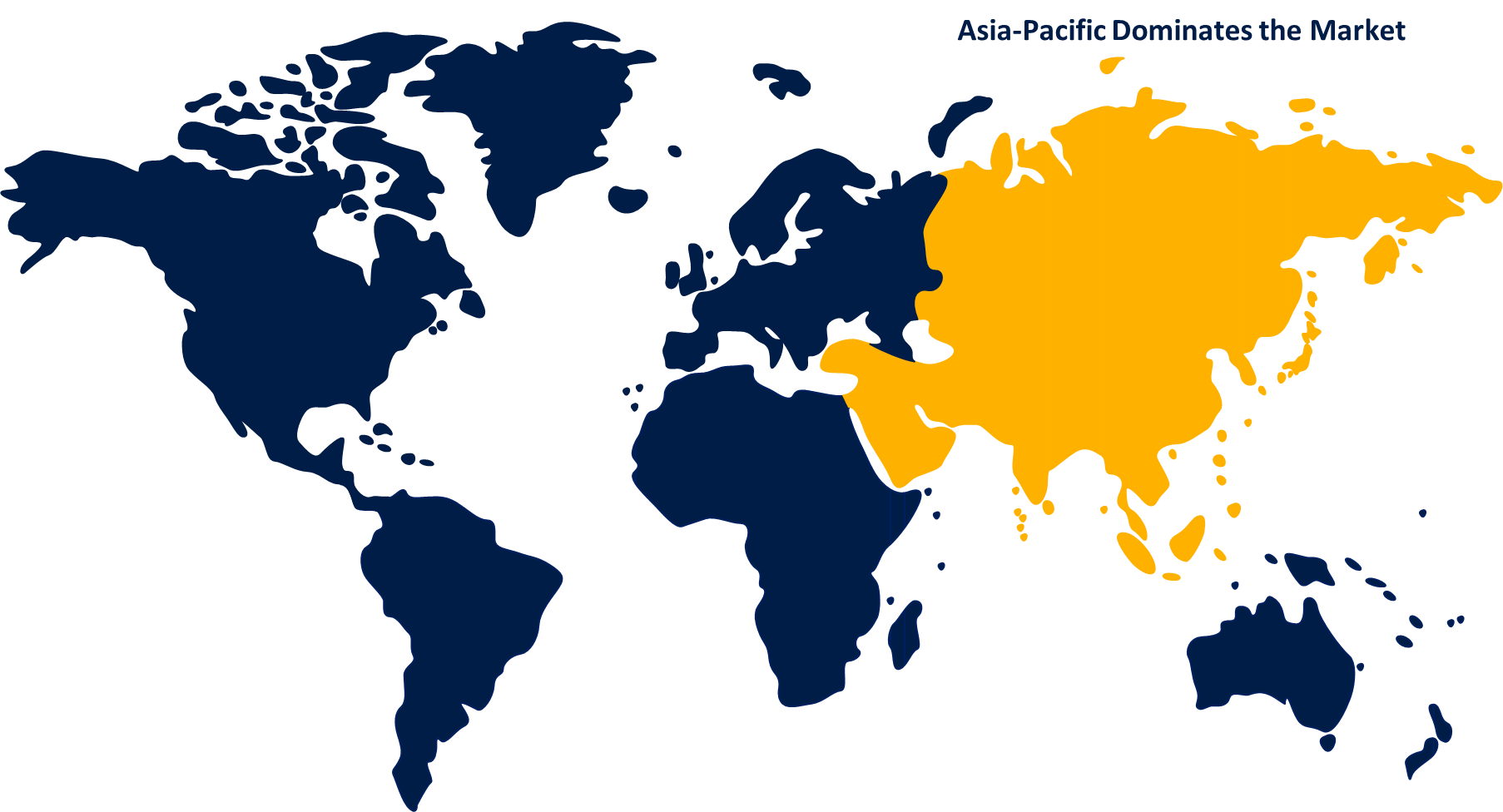Global Sustainable Packaging Market Size By Packaging Type (Recycled content packaging, Reusable packaging, Degradable packaging) By Material (Glass, Paper, Metal, Plastic) By Application (Food & beverage, Personal care, Healthcare, Others) & Forecast, 2022 - 2032.
Industry: Advanced MaterialsThe Global Sustainable Packaging Market Size to grow from USD 110.4 Biillion in 2022 to USD 251.8 Billion by 2032, at a Compound Annual Growth Rate (CAGR) of 8.4% during the forecast period.
Sustainable packaging is the design and use of materials and techniques for packaging that have a low impact on society and the environment. Reduced waste, resource conservation, reduced greenhouse gas emissions, and encouragement of responsible material use are the objectives of sustainable packaging. Customers were increasingly looking for goods with environmentally friendly and sustainable packaging. Numerous businesses were implementing sustainable packaging strategies as a result of this change in consumer expectations. Due to consumer concern over the enormous packaging waste produced by online shopping, the expansion of e-commerce has increased the demand for packaging materials that are not only protective but also lightweight, recyclable, and simple to discard. The adoption of sustainable packaging was significantly influenced by the accessibility and effectiveness of recycling and waste management systems. To ensure that recyclable and compostable waste were handled properly, these mechanisms needed to be improved.

Get more details on this report -
The Global Sustainable Packaging Market Size to grow from USD 110.4 Biillion in 2022 to USD 251.8 Billion by 2032, at a Compound Annual Growth Rate (CAGR) of 8.4% during the forecast period.
Impact of COVID 19 On Global Sustainable Packaging Market
Some governments temporarily lifted their bans on single-use plastics in response to worries about the spread of viruses. This was a setback for initiatives to cut down on plastic waste and promote eco-friendly packaging options. The epidemic delayed the availability of sustainable packaging materials by upsetting global supply lines. This had an impact on the creation and use of environmentally friendly packaging. During the epidemic, some customers kept up their dedication to sustainability, but others changed their priorities. Consumer behaviour changed as a result of the economy's unpredictability and health issues, which affected the need for environmentally friendly packaging. Reusable packaging systems had difficulties because of the pandemic's increasing demand for single-use packaging, which was seen as less hygienic and temporarily suffered setbacks. There was an increase in online purchases as a result of lockdowns and social isolation policies. This resulted in a rise in demand for environmentally friendly packaging options that also safeguard goods in transit.
Global Sustainable Packaging Market Report Coverage
| Report Coverage | Details |
|---|---|
| Base Year: | 2022 |
| Market Size in 2022: | USD 110.4 Billion |
| Forecast Period: | 2022-2032 |
| Forecast Period CAGR 2022-2032 : | 8.4% |
| 2032 Value Projection: | USD 251.8 Billion |
| Historical Data for: | 2017-2021 |
| No. of Pages: | 200 |
| Tables, Charts & Figures: | 110 |
| Segments covered: | By Packaging Type, By Material, By Application and COVID 19 Impact |
| Companies covered:: | Sealed Air Corporation, Plastipak Holdings, Inc., Sonoco Products Company, Amcor plc, BASF SE, Mondi plc, DS Smith plc, Emerald Packaging, Nampak Ltd., Tetra Pak, Smurfit Kappa Group PLC, WestRock Company, Crown Holdings, Inc., Ardagh Group S.A., Ball Corporation, Elopak AS, SGF Packaging Co., Ltd., and other key vendors. |
| Pitfalls & Challenges: | COVID-19 Empact, Challenge, Future, Growth & Analysis. |
Get more details on this report -
Market Dynamics
Sustainable Packaging Market Dynamics
Increasing development of biodegradable packaging
When exposed to particular environmental factors (such as sunlight, moisture, and microbes), biodegradable packaging materials naturally decompose into non-toxic components including water, carbon dioxide, and biomass. As opposed to conventional plastics, which can linger in the environment for hundreds of years, they are therefore a more environmentally responsible option. Food and beverage, cosmetics, medicines, and other businesses can all benefit from the usage of biodegradable packaging. It offers a variety of packaging options, including bags, containers, films, and trays. Even though biodegradable packaging has many benefits, it's crucial to take into account elements like suitable disposal infrastructure and labelling to make sure that these materials degrade properly in actual usage.
Rapid demand for innovative materials
Reducing the usage of single-use plastics, which have grown to be a significant environmental concern, requires the use of innovative materials. Alternatives are being sought by corporations, governments, and consumers. A variety of cutting-edge materials, such as bioplastics, bio-based materials, packaging made of algae, packaging made of mycelium (mushrooms), and edible packaging are now available in the market for sustainable packaging. In place of conventional plastics, these materials offer environmentally preferable options. A wider range of items, including food and beverages, can now use these materials due to improvements in their barrier qualities. For the use of sustainable materials, this expansion of applications is essential.
Restraints & Challenges
Huge cost associated with the sustainability packaging
The initial cost of sustainable materials, such bioplastics or recycled components, may be higher than that of conventional materials, like virgin plastics. Costs can eventually be reduced, though, as a result of economies of scale, improvements in production technology, and rising demand. Businesses may find it challenging to charge consumers more for sustainable packaging in markets that are competitive. Profit margins may be affected, and adoption may be hampered. The willingness of consumers to pay more for environmentally friendly packaging varies by market and demographic. Businesses must carefully evaluate if customers are willing to bear the extra expenses. Putting sustainable packaging solutions into practise may need for specialised knowledge and skill, which could result in consultation or training fees.
Regional Forecasts
Europe Market Statistics
Europe is anticipated to dominate the Sustainability Packaging market from 2023 to 2032. European nations have established objectives to decrease plastic waste and boost recycling rates. As a result, recycling methods and alternative packaging materials have been created and adopted. The use of recycled materials in package production is becoming more and more important. The Single-Use Plastics Directive of the EU requires more recycled material to be used in certain types of packaging. European companies have embraced the idea of a circular economy, where products are reused, recycled, and repurposed. Achieving a circular economy involves packaging significantly. The demand for recyclable, safe, lightweight packaging solutions has grown as e-commerce has developed throughout Europe.
Asia Pacific Market Statistics

Get more details on this report -
Asia Pacific is witnessing the fastest market growth between 2023 to 2032. Some of the fastest-growing economies in the world are found in the Asia-Pacific area. Consumers are becoming more environmentally concerned and looking for products with sustainable packaging as disposable incomes rise. There is an increase in demand for packaging materials that are not just ecological but also protective and economical to ship, as e-commerce grows in nations like China, India, and Southeast Asian countries. Many companies in the Asia-Pacific area have set sustainability goals and targets, including pledges to lower carbon emissions from packaging and plastic waste.
Segmentation Analysis
Insights by Packaging Type
The recycled packaging type segment accounted for the largest market share over the forecast period 2023 to 2032. A circular economy, in which things are recycled and reused, is gaining popularity. By completing the loop on the product lifetime, recycled packaging materials are essential to the development of a circular economy. Even while the initial cost of recycled materials may be higher than the cost of virgin materials, there may be long-term cost savings associated with waste disposal, the purchase of raw resources, and resource conservation. Durability, performance, and aesthetic issues have all been addressed through design advancements in recycled packaging materials. Functionality-wise, recycled materials are becoming more and more competitive. Recycled packaging can help brands gain the trust and loyalty of consumers who care about the environment, increasing market share and customer retention.
Insights by Material
The paper segment accounted for the largest market share over the forecast period 2023 to 2032. The majority of paper items may be recycled numerous times, and paper-based packaging is simple to recycle. This supports the goals of waste reduction and the circular economy. Paper is naturally decomposable and intrinsically biodegradable, making it a desirable option for businesses trying to lessen the environmental effect of their packaging. E-commerce expansion has boosted demand for safe and environmentally friendly packaging materials. For transportation, corrugated cardboard and other paper-based packaging materials are frequently utilised.
Insights by Application
The food and beverage segment accounted for the largest market share over the forecast period 2017 to 2032. Brands of food and beverages that prioritise sustainable packaging can improve their reputation and image. Consumers frequently link ethical and responsible business practises to sustainability. To lessen the environmental impact of packaging, the food and beverage sector is aggressively investigating cutting-edge technologies including bio-based plastics, edible packaging, and mycelium-based packaging. To guarantee that environmentally friendly packaging materials are efficiently managed, food and beverage companies are aggressively educating consumers about proper disposal and recycling procedures.
Recent Market Developments
- In March 2023, Hinojosa Packaging Group, based in Spain, unveiled a brand-new industrial food service line featuring packaging options made entirely of recyclable materials. The company wants to highlight sustainable eating habits in the food sector with this launch.
Competitive Landscape
Major players in the market
- Sealed Air Corporation
- Plastipak Holdings, Inc.
- Sonoco Products Company
- Amcor plc
- BASF SE
- Mondi plc
- DS Smith plc
- Emerald Packaging
- Nampak Ltd.
- Tetra Pak
- Smurfit Kappa Group PLC
- WestRock Company
- Crown Holdings, Inc.
- Ardagh Group S.A.
- Ball Corporation
- Elopak AS
- SGF Packaging Co., Ltd.
Market Segmentation
This study forecasts revenue at global, regional, and country levels from 2022 to 2032.
Sustainability Packaging Market, Packaging Analysis
- Recycled content packaging
- Reusable packaging
- Degradable packaging
Sustainability Packaging Market, Application Analysis
- Glass
- Paper
- Metal
- Plastic
Sustainability Packaging Market, Material Analysis
- Food & beverage
- Personal care
- Healthcare
- Others
Sustainability Packaging Market, Regional Analysis
- North America
- US
- Canada
- Mexico
- Europe
- Germany
- Uk
- France
- Italy
- Spain
- Russia
- Rest of Europe
- Asia Pacific
- China
- Japan
- India
- South Korea
- Australia
- South America
- Brazil
- Argentina
- Colombia
- Middle East & Africa
- UAE
- Saudi Arabia
- South Africa
Frequently Asked Questions (FAQ)
-
What is the market size of the Sustainability Packaging Market?The global Sustainability Packaging Market is expected to grow from USD 110.4 Billion in 2023 to USD 251.8 Billion by 2032, at a CAGR of 8.4% during the forecast period 2023-2032.
-
Who are the key market players of the Sustainability Packaging Market?Some of the key market players of market are Sealed Air Corporation, Plastipak Holdings, Inc., Sonoco Products Company, Amcor plc, BASF SE, Mondi plc, DS Smith plc, Emerald Packaging, Nampak Ltd., Tetra Pak, Smurfit Kappa Group PLC, WestRock Company, Crown Holdings, Inc., Ardagh Group S.A., Ball Corporation, Elopak AS, SGF Packaging Co., Ltd.
-
Which segment holds the largest market share?Paper segment holds the largest market share are going to continue its dominance.
-
Which region is dominating the Sustainability Packaging Market?Europe is dominating the Sustainability Packaging Market with the highest market share.
Need help to buy this report?